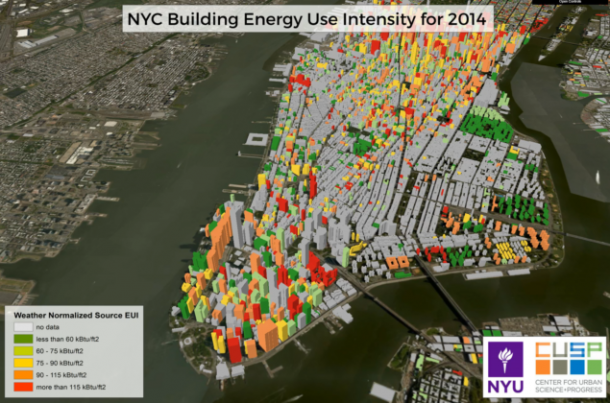Constantine Kontokosta Is on the Frontlines of Using Data for Good in Cities

Assistant Professor Constantine Kontokosta (second from right) works with sensors developed by his lab that generate data to better understand how cities work.
Constantine Kontokosta — Assistant Professor in Tandon’s Department of Civil and Urban Engineering and the NYU Center for Urban Science and Progress (CUSP), the Director of the Urban Intelligence Lab, and the Deputy Director for Academics at CUSP — is using data analytics to advance the fundamental understanding of how cities work and how data-driven decision-making can improve city operations, policy, and planning.
Building on his recent National Science Foundation CAREER award and grants from the MacArthur Foundation and the Mayor’s Office of Sustainability, he’s making a difference in New York City ... and beyond.
Up for the Challenge
Kontokosta and his team were recently selected as one of only six winners — from a field of several hundred — in the U.N. Data for Climate Action Challenge, a call to the world’s data scientists, researchers, analysts, and innovators to develop viable, data-driven climate solutions. With climate change now a global issue threatening entire ecosystems and cultures, the Challenge aims to demonstrate the transformative and vital possibilities of harnessing Big Data to address the problem.
The team developed a first-of-its kind high-resolution spatial-temporal model of urban greenhouse gas emissions from buildings, transportation systems, and point sources such as power generation facilities and industrial plants. They used a staggering array of data, including:
- city records,
- Department of Energy models,
- information from mobile traffic apps,
- high-resolution weather station records,
- Twitter feeds,
- Department of Transportation traffic counts, and
- particulate matter concentrations from deployed sensors, among other sources.
Kontokosta will present the team’s work at the 2017 U.N. Climate Change Conference (COP23) in Bonn, Germany, this month, adding to the growing evidence of the value of big data and public-private cooperation for climate action and sustainable development.
When the Mayor Calls
Kontokosta and his team have partnered with Mayor Bill de Blasio, to help him meet his ambitious goals to create more energy-efficient buildings and reduce emissions by helping prepare a comprehensive analysis of the energy and water usage of large buildings in New York City. This is a part of a multi-year collaboration to reduce energy and carbon emissions from buildings using data and computational methods.
Their latest report found that between 2010 and 2015 greenhouse gas emissions from more than 4,000 regularly benchmarked properties dropped by 14 percent, while energy use decreased 10 percent. (Benchmarking refers to the process of gathering the data and using it to compare the buildings’ energy performance against that of similar buildings; since 2009, when New York City began requiring owners of large buildings to report the amount of energy and water they use each year, the process — and the analytical methods Kontokosta developed with New York City — have since been adopted by many other major cities.) His research on the topic has been published in several leading journals, including Applied Energy, Energy Policy, Energy & Buildings, and the Annals of the NY Academy of Sciences.

Energy benchmarking data is used to compare buildings’ energy performance against that of similar buildings
"This year's report represents another significant step forward in using data analytics to address the serious urban challenge of climate change," Kontokosta explained. "New York City continues to lead on climate action, and further data-driven, evidenced-based policies are necessary to achieve the Mayor's ambitious goals."
Kontokosta has just started a new project with the City, one that will help New York and other urban areas around the world better understand the causes and patterns of urban carbon emissions and ways to model the impact of future policy and developments scenarios to minimize the negative effects of climate change, particularly for those most vulnerable.
Livable Neighborhood, Living Lab
Kontokosta heads the Quantified Community Research Initiative — a groundbreaking project that is making Hudson Yards, the 28-acre, 20-million square foot “city-within-a-city” on the west side of Manhattan, the nation’s first fully instrumented and quantified community lab. He’s since expanded the initiative with projects in Lower Manhattan, Red Hook, and, most recently, the Brownsville neighborhood of Brooklyn.
Data in a “Quantified Community” is generated by deployed sensors developed by Kontokosta’s Lab, smart building systems, social media, and various City records, with additional data supplied through “crowd-sourcing” from citizen scientists who volunteer data that might be generated by smartphones or wearable technologies.
It’s an exciting collaborative effort that recently got even more exciting — and more collaborative — thanks to an announcement from the mayor’s office that Brownsville will also be home to multiple NYCx Co-Lab Challenges. The Challenges are aimed at enabling members of the community to voice concerns on a neighborhood level and work with entrepreneurs to address problems, create prototype solutions, and apply, test, and grow emerging technologies. (NYCx is the world’s first municipal program to transform urban spaces into hubs for tech collaboration, research, testing, and development.)
"The NYCx Co-Lab in Brownsville creates an unprecedented opportunity for researchers to work directly with residents to understand and address problems most important to the community," Kontokosta said. "By building on the lessons from our Quantified Community research initiative, we hope to show how data can be used to help communities become empowered to take action based on rigorous, evidenced-based analysis of what civic technologies and urban innovations work best for them."


